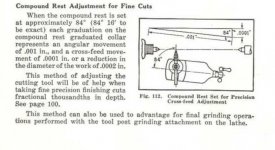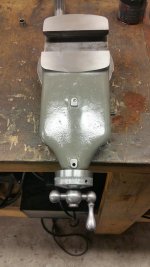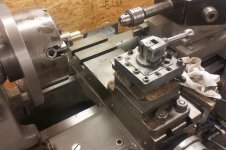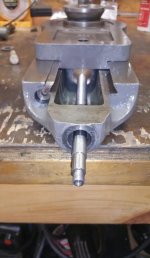texasgeartrain
Titanium
- Joined
- Feb 23, 2016
- Location
- Houston, TX
I have what may seem like random, or all over the place questions or thoughts in relation to tool post placement and compound rest use and general location placement of it. But I'm working toward what I hope is the best overall positioning and use of the combination.
And I do understand, that to certain degree, its a loaded question, or tough to answer, as there are nearly endless set ups, ways of doing things, or varying work specific circumstances.
But in very basic or general terms some questions I have:
1. Are you guys generally setting compound rest to 84 degrees, I presume to better sneak up on work and get finer results in sub .001" range ?
2. If so, are you aligning tool post 90 degress to work ?
3. Are you generally biasing your tool post to one side or the other on the rest, or planting it in the middle? And are you using full length tee nuts to edge of tee slot to reduce chip gathering places ?
4. Generally, do you keep tool post side, of the upper portion of compound rest, right on the edge of the intermediate section ? For cleanliness, to reduce chips on that dovetail ?
5. Do you find you drive the rest back and forth its full range ? Or are you operating in a small range ? If you're using the full range, what's the common circumstance ?
I probably have more, but i didn't write it down, now its flown away, lol.
And I do understand, that to certain degree, its a loaded question, or tough to answer, as there are nearly endless set ups, ways of doing things, or varying work specific circumstances.
But in very basic or general terms some questions I have:
1. Are you guys generally setting compound rest to 84 degrees, I presume to better sneak up on work and get finer results in sub .001" range ?
2. If so, are you aligning tool post 90 degress to work ?
3. Are you generally biasing your tool post to one side or the other on the rest, or planting it in the middle? And are you using full length tee nuts to edge of tee slot to reduce chip gathering places ?
4. Generally, do you keep tool post side, of the upper portion of compound rest, right on the edge of the intermediate section ? For cleanliness, to reduce chips on that dovetail ?
5. Do you find you drive the rest back and forth its full range ? Or are you operating in a small range ? If you're using the full range, what's the common circumstance ?
I probably have more, but i didn't write it down, now its flown away, lol.



















